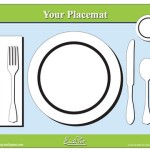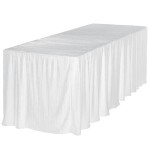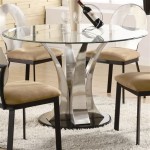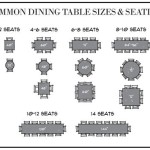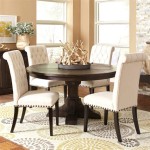Can You Use Placemats On Top Of A Tablecloth? Exploring Table Setting Options
The question of whether to use placemats on top of a tablecloth is a common one, often arising when individuals seek to refine their table setting aesthetics or protect their table surfaces from potential damage. The answer, in short, is yes, placemats can certainly be used over a tablecloth. However, the effectiveness and appropriateness of this combination depend on several factors, including the desired aesthetic, the formality of the event, the materials of both the placemats and tablecloth, and the practical considerations of protecting the table itself. This article explores these factors in detail, offering guidance on how to best integrate placemats and tablecloths for a cohesive and functional table setting.
Historically, tablecloths served primarily as a protective layer for the table. They shielded the wood from spills, scratches, and heat damage. Over time, tablecloths evolved into decorative elements, reflecting personal style and setting the tone for a meal. Placemats, on the other hand, gained popularity as individual settings that could be easily cleaned and replaced, offering a more casual alternative to full tablecloths. The modern approach to table setting often involves combining these elements, creating a layered and visually appealing arrangement.
Aesthetic Considerations: Layering for Visual Appeal
The primary reason for using placemats on top of a tablecloth is often aesthetic. Layering creates visual interest and adds depth to the table setting. The contrast between the tablecloth and placemats can highlight the individual place settings, drawing attention to the dinnerware and cutlery. Successful layering requires careful consideration of color, texture, and pattern.
Color coordination is crucial. A neutral tablecloth, such as white, cream, or gray, provides a versatile backdrop for placemats in various colors and patterns. Conversely, a patterned tablecloth might be paired with solid-colored placemats that complement one of the colors within the pattern. The goal is to create a harmonious balance rather than a clashing combination. For example, a light blue tablecloth might be paired with navy blue or silver placemats for a sophisticated look, or with yellow placemats for a more vibrant and cheerful setting. Avoid using placemats and tablecloths with overly busy patterns that compete with each other.
Texture plays a significant role in adding depth. A linen tablecloth, for example, offers a natural and slightly rustic texture that can be contrasted with smooth, modern placemats made of materials like vinyl or cork. Conversely, a smooth, satin tablecloth can be paired with textured placemats made of woven materials or natural fibers like jute or seagrass. The interplay of different textures adds tactile interest and prevents the table setting from appearing flat or monotonous.
Pattern mixing should be approached with caution. While it can be visually striking, it requires a keen eye for design. A safe approach is to combine a subtle pattern with a bolder one, ensuring that the patterns share a common color or motif. For instance, a tablecloth with a small geometric print could be paired with placemats featuring a larger floral pattern, provided that the colors are complementary. Remember to maintain a sense of balance and avoid overwhelming the eye with too much visual information.
Formality and Occasion: Adjusting to the Event
The formality of the event dictates the appropriateness of using placemats on top of a tablecloth. For formal occasions, such as weddings or holiday dinners, a full tablecloth is generally considered essential. Adding placemats in this context can enhance the elegance and sophistication of the setting. For more casual gatherings, such as family meals or informal dinner parties, the choice is more flexible. A simple tablecloth with placemats can create a relaxed yet stylish atmosphere.
For formal events, consider using high-quality materials for both the tablecloth and placemats. Linen, damask, or silk tablecloths paired with elegant placemats made of materials like silver, gold, or embroidered fabric can elevate the table setting to a higher level of sophistication. The attention to detail in the materials and design reflects the importance of the occasion.
For casual events, practical considerations often take precedence. Easy-to-clean materials like cotton or polyester for the tablecloth and vinyl or cork for the placemats are ideal for minimizing cleanup time. The focus should be on creating a comfortable and inviting atmosphere where guests feel relaxed and at ease. Bright colors and playful patterns can add a touch of informality and create a cheerful ambiance.
The season can also influence the choice of tablecloth and placemat combinations. During the spring and summer, lighter colors and floral patterns are often preferred, while during the fall and winter, richer colors and heavier fabrics are more appropriate. Matching the table setting to the season adds a thoughtful touch and enhances the overall dining experience.
Practical Considerations: Protection and Functionality
Beyond aesthetics, placemats serve a practical purpose: protecting the tablecloth from stains, spills, and heat damage. While a tablecloth offers a general layer of protection, placemats provide targeted protection for individual place settings. This is particularly important when serving messy foods or hot dishes that could potentially damage the tablecloth. The choice of placemat material significantly impacts its protective capabilities.
Heat resistance is a critical factor, especially when serving hot dishes directly from the oven or stovetop. Placemats made of materials like cork, silicone, or heat-resistant fabric are ideal for protecting the tablecloth from scorching or melting. Avoid using placemats made of materials that are prone to melting or deforming under high temperatures, such as certain types of plastic.
Stain resistance is another important consideration. Placemats made of materials like vinyl, treated cotton, or stain-resistant fabric are easy to wipe clean and prevent spills from seeping into the tablecloth. Dark colors and patterns can also help to conceal stains, making them a practical choice for families with young children or for events where spills are likely to occur. Regularly cleaning placemats is essential to maintain their appearance and prevent stains from becoming permanent.
The size and shape of the placemats should also be considered in relation to the size and shape of the dinnerware and the overall table setting. Placemats should be large enough to accommodate the dinner plate, cutlery, and glassware without appearing cramped or cluttered. Standard rectangular or round placemats are versatile and can be easily adapted to different table settings. However, more unconventional shapes, such as oval or square placemats, can add a touch of personality and visual interest.
Finally, consider the ease of storage. Placemats should be easy to store when not in use, either by stacking them flat or rolling them up. Materials that are prone to creasing or wrinkling should be avoided, as they require ironing before each use. Choosing placemats that are durable and easy to maintain ensures that they will remain a valuable part of your table setting for years to come.
In summary, incorporating placemats on top of a tablecloth is a viable and often desirable choice for enhancing table settings. By carefully considering the aesthetic, formality, and practical aspects, one can create a visually appealing and functional dining environment. The key is to balance the elements, ensuring that the tablecloth and placemats complement each other in terms of color, texture, pattern, and material, ultimately creating a cohesive and inviting ambiance.
The Great Debate Placemats Or Tablecloths Which Are Better Lc Studios

How To Use Placemats Ultimate Style Guide French Affair

How To Set The Table With Placemats

How To Use Placemats Ultimate Style Guide French Affair

5 Ways To Decorate A Table With Runner Pottery Barn

Should You Use Placemats With A Tablecloth Combinations Positioning Tips Tablecoversnow Com

7 Tips For Storing Your Table Linens

How To Use Table Runners At Home House Garden

20 40 60 Etiquette Setting The Table Tone For Your Dinner Party

Can You Do A Square Tablecloth On Round Table With Runner Centerpieces For Home Dining Cloth Farmhouse Room
Related Posts


